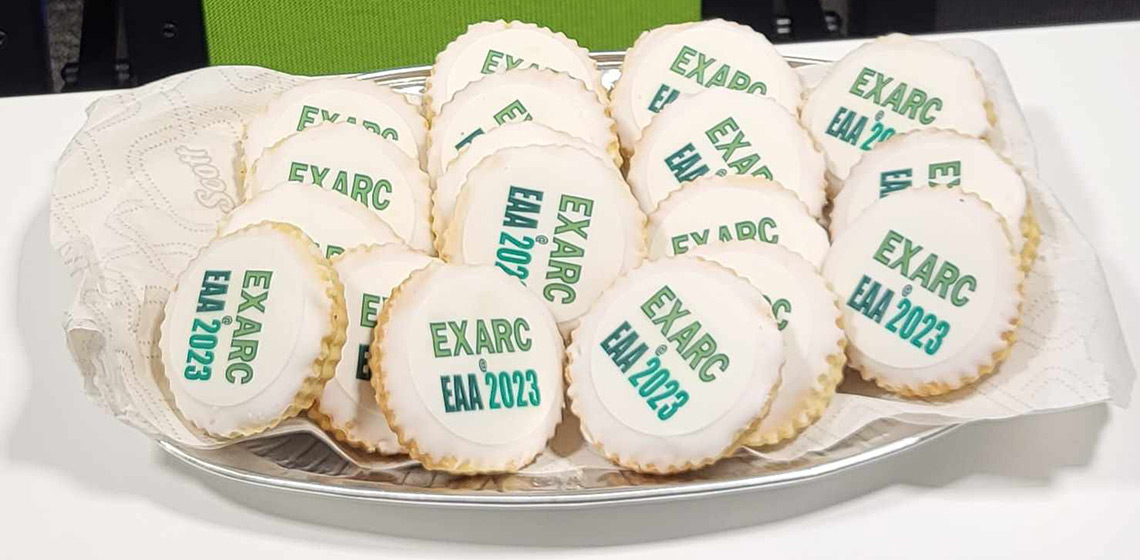The content is published under a Creative Commons Attribution Non-Commercial 4.0 License.
Unreviewed Mixed Matters Article:
Conference Review: EXARC at the EAA, Belfast, September 2023

EXARC was featured at a session at the 2023 conference of the European Association of Archaeologists in Belfast, Northern Ireland. The theme of the conference was Weaving Narratives. With this in mind the session considered how EXARC weaves multiple narratives among its members, through events, conferences, fellowships, and how the organisation connects people all over the world.
The purpose of the session, co-chaired by Brendan O’Neill and Rena Maguire (UCD) and Giovanna Fregni, was to bring together researchers working in different fields who engage in experimental archaeology as part of their work. Its aim was to fuse experimental and experiential archaeology with reconstructing past narratives. The session was well-attended, and not only because of the bespoke EXARC biscuits! The papers were divided into the categories of organic materials, pyrotechnic processes, and educational and cultural significance.
The organic materials session began with Billy Sines’ paper on reconstructing Early Medieval Irish combs, in which he not only explored the status of the objects, but also the tools and reasons behind their design and manufacture. This was followed by Matilda Siebrecht’s presentation on Paleo-Inuit needle making and sewing practices, in which she showed her research studying with modern Inuit seamstresses. Tiffany Okaluk’s presentation quantified butchery marks that are the result of social food processing traditions. Her research will help identify these processes with more precision. Hamish Darrah experimented with splitting, working and dressing oak planks, along with tool use and evidence of tool marks. Agnese Čakare explored the technology of Baltic amber production, identifying tools and processes used to shape the material, along with the study of knowledge transmission. Her experimental work with amber was compared to objects from a Neolithic amber processing site in Siliņupe, Latvia.
After the break Tetiana Yriivna Hoshko started the pyrotechnics session with a presentation on Bronze Age hairpins from the Hordiivka burial mound in Ukraine that could have functioned as insignia. Various experiments were undertaken to explore their manufacture, in addition to interpreting their purpose. This was followed by Darrell Markewitz’s report on the ongoing Turf to Tools Project that conducts bloomery iron smelts based on archaeological investigations in Rhynie, Aberdeenshire, Scotland.
Continuing with the iron-based theme, Adi Eliyahu-Behar’s experiments sought to identify iron ore sources in the Levant. The bloomery iron smelting used both shaft-tapping and bowl furnaces with ore from the Negev region in southern Israel. Averil White presented her work on pinched crucibles from Early Medieval Ireland, noting that similar crucibles are also found in Britain and the continent. Her research explores themes such as elite trades, transmission of knowledge and the movement of people across considerable distances. Rena Maguire’s presentation discussed the lack of equestrian material in Ireland’s early medieval period,using experimental archaeology to account for that paucity, by making a set of harness from straw. Chase Minos presented his experimental work replicating Late Cypriot pottery from Enkomi that made use of the potter’s wheel, an emerging technology. Ceramic petrography, sediment sampling, and experiments in manufacturing ceramics explored the effects of rounded sand grains on the plasticity and workability of the ceramic paste.
The final session focussed on education, cultural significance and public interaction. The session began with Ladisslav Rytir’s discussion of historical memory through the 1620 Cesta k porážce project that commemorates the Bohemian revolt of 1618-1620. The project involved reconstructing gabion walls and artillery platforms. The project also includes lectures, an exhibition, and public engagement aimed at bringing together professionals, reenactors and the general public. Anita Radni’s paper presented how experimental archaeology is fundamental to protecting cultural heritage in North Africa. Climate change, desertification, and economic emigration is changing the face of centuries old craft traditions. Lost craft techniques are being restored and recorded for posterity through the use of oral tradition and experimental archaeology. The author highlighted one project that focusses on traditional dyeing techniques using analyses of materials recovered from abandoned villages. Giovanna Fregni spoke about the Vounous Symposium in Northern Cyprus and how it is a catalyst for building community through public interaction, education, and the recreation of the island’s lost patrimony of Bronze Age ceramics. She concluded the talk with the announcement that the symposium’s directors are planning the creation of an open-air museum. Brendan O’Neill presented the CLaSS project (Cultural Landscapes and Social Spaces). CLaSS is a long-term interdisciplinary programme that combines architecture, structural engineering, forestry, ecology, folklore, history and archaeology to examine life in Iron Age and early medieval Ireland. The session ended with Peter Kienzle’s examined Roman hypocaust systems using 3D digital modelling to create a computer-generated airflow model that illustrated the heating process. This led to a new understanding of the thermal qualities of Roman tiles and their capacity for thermal expansion, combining traditional handcraft building materials with modern technological research.
The session generated lively discussions during the question and answer periods and during the breaks. At the beginning of the session, it was announced that there would be a post-proceedings publication of the session papers for all participants who were interested in contributing. Publication is planned for later this year.
EXARC continues to grow and provide resources for students, independent researchers, professional academics, and established archaeologists. It weaves a narrative among its members and encourages collaborations. As EXARC has grown over the years it has founded relationships around the world. As people who work in craft, they acknowledge that no craft exists in a vacuum. An artisan relies on the skills of others who supply tools and raw materials, thus providing an interactive sphere of creation. Likewise researchers rely on the previous work of earlier researchers, often from entirely different fields. It is with hope for future research and in the spirit of collaboration that we thank everyone who participated in the session, and EXARC for providing the support for so many projects and research opportunities.
Keywords
Country
- United Kingdom

